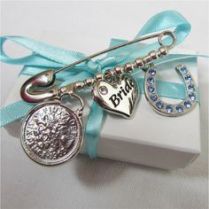 Have you ever wondered why brides borrow something for luck? Have you been thinking why a lot of people still believes in wishing wells? Here’s a look at how some traditional romantic superstitions and rituals became so popular.
Have you ever wondered why brides borrow something for luck? Have you been thinking why a lot of people still believes in wishing wells? Here’s a look at how some traditional romantic superstitions and rituals became so popular.
Do you have a lucky pair of earrings that you like to wear on first dates? Are you strict about waiting to call a new crush exactly three days after meeting each other? Will you find something old, something new, something borrowed and something blue to wear on your wedding day? If you answered “yes,” then you’re just like the rest of us — a little superstitious about love. And why not? Superstitions
“Superstitions are the illusion of control over fate, They offer the comfort of believing we can offset the chance of unwanted outcomes and increase our chances of future good. Many of my clients have a shirt or dress or particular color they always wear on first dates. These ‘amulets’ give a boost to positive feelings and confidence.” But where, exactly, did our odd love superstitions come from? Read on for the dirt behind that your favorite love rituals…
 Throwing a coin into a well and making a wish
Throwing a coin into a well and making a wish![]()
“Wells, being a source of water, became symbols of fruitfulness, If a woman stood by a well and made a wish, it was supposed to come true. In the olden times, she usually wished for a husband and children, and then dropped in her coin. If she saw her own reflection, her wish was bound to come true. This superstition is symbolic and applicable in today’s world, because we often attract others to us that are a reflection of our true selves.”
Plucking off the petals of a daisy![]()
“For centuries throughout Europe and North America, the daisy was — and still is — a love-struck woman’s Tarot,” says Karinna Kittles-Karsten, who runs Sacredlove.com. “The petals reveal to her the fate of the relationship she so passionately desires, and if she doesn’t like the daisy’s answer, she can always pick another!” The “daisy oracle” superstition arose from a maiden’s game played in medieval France called effeuiller la marguerite, which means “to thin the leaves of a daisy.” The rhyme that subsequently evolved in English to become “he loves me, he loves me not” was first printed in a 15th century songbook. A similar superstition involves twisting the stem of an apple while reciting the names of potential loves. The name you say when the stem comes off is the person who is meant for you.
 Waiting three days to call someone
Waiting three days to call someone![]()
This superstition really took off after the movie Swingers became popular in the late 1990s. More of a rule of thumb, the practice is said to prevent the caller from looking desperate. Though Barney Stinson on How I Met Your Mother claims Jesus invented the three-day rule by waiting three days to come back to life, the truth is that this tired modern-day superstition is a good one to break.
Kissing at midnight on New Year’s Eve/under the mistletoe![]()
A kiss to ring in the next year is a sign of celebration. It’s also an expression of our superstition that the way we begin the year will set the tone for the next 365 days that follow. So, that midnight kiss reflects our wish for a year full of affection. Similarly, kissing under the mistletoe during the holidays began as means to ward off evil and welcome love and romance into our homes. The Druids named mistletoe the “all-healing” plant, because they believed it had special powers. Kissing under the mistletoe is thought to have originated at Saturnalia festivals in the time of the ancient Greeks.
 Throwing rice at the bride and groom
Throwing rice at the bride and groom![]()
Have you ever wondered why wedding guests throw rice at newly married couples? Seems a bit hostile, but it’s actually anything but; instead, this superstitious tradition comes from the ancient Hebrew, Assyrian and Egyptian cultures as a symbol of fertility and good fortune. In Chinese tradition, the idea is that the rice will encourage any nearby spirits to have a snack instead of pestering the happy couple.
Losing your engagement ring is a bad sign![]()
“As a psychic medium, I have been asked to find many diamond engagement rings,” recounts psychic consultant Betsy Balega. “Over the years, each ring was found — but how many of these prospective brides walked down the aisle? Zero! At first I thought it was just a coincidence, but after seven brides had their grooms break off the nuptials, I became a firm believer that losing your engagement ring is not a good omen.” In other words, don’t start wearing your ring around until you get it sized properly… and don’t take it off!
 Carrying something old, new, borrowed and blue on your wedding day
Carrying something old, new, borrowed and blue on your wedding day![]()
“The borrowed, blue, old, and new motif helps the bride and groom feel lucky,” says Dr. Page. The rhyme was coined in Victorian times and is based on a mish-mash of traditions. The “blue” symbolizes purity, fidelity and loyalty, going back to Biblical traditions (Israelite brides wore blue ribbons in their hair or a garment bordered in blue); later, the color was mentioned in a proverb that was popular before the late 19th century: “Marry in blue, lover be true.” The “old” part of the rhyme shows the couples’ intention to retain and deepen their existing family connections, even as they begin a “new” family. “Something borrowed” is a token given to the bride that symbolizes the love and support of her friends.

